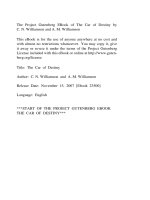The Project Gutenberg eBook of Spherical Trigonometry, by I. Todhunter potx
Bạn đang xem bản rút gọn của tài liệu. Xem và tải ngay bản đầy đủ của tài liệu tại đây (789.34 KB, 189 trang )
The Project Gutenberg eBook of Spherical Trigonometry,
by I. Todhunter
This eBook is for the use of anyone anywhere at no cost and with
almost no restrictions whatsoever. You may copy it, give it away or
re-use it under the terms of the Project Gutenberg License included
with this eBook or online at www.gutenberg.net
Title: Spherical Trigonometry
For the use of colleges and schools
Author: I. Todhunter
Release Date: November 12, 2006 [EBook #19770]
Language: English
Character set encoding: TeX
*** START OF THIS PROJECT GUTENBERG EBOOK SPHERICAL TRIGONOMETRY ***
Produced by K.F. Greiner, Berj Zamanian, Joshua Hutchinson and
the Online Distributed Proofreading Team at
(This file was produced from images generously made available
by Cornell University Digital Collections)
SPHERICAL
TRIGONOMETRY.
ii
SPHERICAL TRIGONOMETRY
For the Use of Colleges and Schools.
WITH NUMEROUS EXAMPLES.
BY
I. TODHUNTER, M.A., F.R.S.,
HONORARY FELLOW OF ST JOHN’S COLLEGE,
CAMBRIDGE.
FIFTH EDITION.
London :
MACMILLAN AND CO.
1886
[All Rights reserved.]
ii
Cambridge:
PRINTED BY C. J. CLAY, M.A. AND SON,
AT THE UNIVERSITY PRESS.
PREFACE
The present work is constructed on the same plan as my treatise on Plane
Trigonometry, to which it is intended as a sequel; it contains all the propositions
usually included under the head of Spherical Trigonometry, together with a large
collection of examples for exercise. In the course of the work reference is made
to preceding writers from whom assistance has been obtained; besides these
writers I have consulted the treatises on Trigonometry by Lardner, Lefebure de
Fourcy, and Snowball, and the treatise on Geometry published in the Library of
Useful Knowledge. The examples have been chiefly selected from the University
and College Examination Papers.
In the account of Napier’s Rules of Circular Parts an explanation has been
given of a method of proof devised by Napier, which seems to have been over-
looked by most modern writers on the subject. I have had the advantage of
access to an unprinted Memoir on this point by the late R. L. Ellis of Trinity
College; Mr Ellis had in fact rediscovered for himse lf Napier’s own method. For
the use of this Memoir and for some valuable references on the subject I am
indebted to the Dean of Ely.
Considerable labour has been bestowed on the text in order to render it
comprehensive and accurate, and the e xamples have all been carefully verified;
and thus I venture to hope that the work will be found useful by Students and
Teachers.
I. TODHUNTER.
St John’s College,
August 15, 1859.
iii
iv
In the third edition I have made some additions which I hope will be found
valuable. I have considerably enlarged the discussion on the connexion of For-
mulæ in Plane and Spherical Trigonometry; so as to include an account of the
properties in Spherical Trigonometry which are analogous to those of the Nine
Points Circle in Plane Geometry. The mode of investigation is more elementary
than those hitherto employed; and perhaps some of the results are new. The
fourteenth Chapter is almost entirely original, and may deserve attention from
the nature of the propositions themselves and of the demonstrations which are
given.
Cambridge,
July, 1871.
CONTENTS.
I Great and Small Circles. 1
II Spherical Triangles. 7
III Spherical Geometry. 11
IV Relations between the Trigonometrical Functions of the Sides
and the Angles of a Spherical Triangle. 17
V Solution of Right-angled Triangles. 35
VI Solution of Oblique-Angled Triangles. 49
VII Circumscribed and Inscribed Circles. 63
VIII Area of a Spherical Triangle. Spherical Excess. 71
IX On certain approximate Formulæ. 81
X Geodetical Operations. 91
XI On small variations in the parts of a Spherical Triangle. 99
XII On the connexion of Formulæ in Plane and Spherical Trigonom-
etry. 103
XIII Polyhedrons. 121
XIV Arcs drawn to fixed points on the Surface of a Sphere. 133
XV Miscellaneous Propositions. 143
XVI Numerical Solution of Spherical Triangles. 157
v
vi CONTENTS.
I
GREAT AND SMALL
CIRCLES.
1. A sphere is a solid bounded by a surface every point of which is equally
distant from a fixed point which is called the centre of the sphere. The straight
line which joins any point of the surface with the centre is called a radius. A
straight line drawn through the centre and terminated both ways by the surface
is called a diameter.
2. The section of the surface of a sphere made by any plane is a circle.
Let AB be the section of the surface of a sphere made by any plane, O the
centre of the sphere. Draw OC perpendicular to the plane; take any point D
in the section and join OD, CD. Since OC is perpendicular to the plane, the
1
2 GREAT AND SMALL CIRCLES.
angle OCD is a right angle; therefore CD =
√
(OD
2
− OC
2
). Now O and C
are fixed points, so that OC is constant; and OD is constant, being the radius
of the sphere; hence CD is constant. Thus all points in the plane section are
equally distant from the fixed point C; therefore the section is a circle of which
C is the centre.
3. The section of the surface of a sphere by a plane is called a great circle if
the plane passes through the centre of the sphere, and a small circle if the plane
does not pass through the centre of the sphere. Thus the radius of a great circle
is equal to the radius of the sphere.
4. Through the centre of a sphere and any two points on the surface a plane
can be drawn; and only one plane can be drawn, except when the two points
are the extremities of a diameter of the sphere, and then an infinite number of
such planes can be drawn. Hence only one great circle can be drawn through
two given points on the surface of a sphere, except when the points are the
extremities of a diameter of the sphere. When only one great circle can be
drawn through two given points, the great circle is unequally divided at the two
points; we shall for brevity speak of the shorter of the two arcs as the arc of a
great circle joining the two points .
5. The axis of any circle of a sphere is that diameter of the sphere which is
perpendicular to the plane of the circle; the extremities of the axis are called
the poles of the circle. The poles of a great circle are equally distant from the
plane of the circle. The poles of a small circle are not equally distant from the
plane of the circle; they may be called respectively the nearer and further pole;
sometimes the nearer pole is for brevity called the pole.
6. A pole of a circle is equally distant from every point of the circumference of
the circle.
Let O be the centre of the sphere, AB any circle of the sphere, C the centre of
the circle, P and P
the poles of the circle. Take any point D in the circumference
of the circle; join CD, OD, P D. Then P D =
√
(P C
2
+ CD
2
); and PC and CD
are constant, therefore P D is constant. Suppose a great circle to pass through
the points P and D; then the chord P D is constant, and therefore the arc of a
GREAT AND SMALL CIRCLES. 3
great circle intercepted between P and D is constant for all positions of D on
the circle AB.
Thus the distance of a p ole of a circle from every point of the circumference
of the circle is constant, whether that distance be measured by the straight line
joining the points, or by the arc of a great circle intercepted between the points.
7. The arc of a great circle which is drawn from a pole of a great circle to any
point in its circumference is a quadrant.
Let P be a pole of the great circle ABC; then the arc P A is a quadrant.
For let O be the centre of the sphere, and draw PO. Then P O is at right
angles to the plane ABC, because P is the pole of ABC, therefore P OA is a
right angle, and the arc P A is a quadrant.
8. The angle subtended at the centre of a sphere by the arc of a great circle
which joins the poles of two great circles is equal to the inclination of the planes
of the great circles.
4 GREAT AND SMALL CIRCLES.
Let O be the centre of the sphere, CD, CE the great circles intersecting at
C, A and B the poles of CD and CE respectively.
Draw a great circle through A and B, meeting CD and CE at M and N
respectively. Then AO is perpendicular to OC, which is a straight line in the
plane OCD; and BO is perpendicular to OC, which is a straight line in the
plane OCE; therefore OC is perpendicular to the plane AOB (Euclid, xi. 4);
and therefore OC is perpendicular to the straight lines OM and ON, which are
in the plane AOB. Hence MON is the angle of inclination of the planes OCD
and OCE. And the angle
AOB = AOM − BOM = BON −BOM = MON.
9. By the angle between two great circles is meant the angle of inclination of
the planes of the circles. Thus, in the figure of the preceding Article, the angle
between the great circles CD and CE is the angle MON.
In the figure to Art. 6, since PO is perpendicular to the plane ACB, every
plane which contains P O is at right angles to the plane ACB. Hence the angle
between the plane of any circle and the plane of a great circle which passes
through its poles is a right angle.
10. Two great circles bisect each other.
For since the plane of each great circle passes through the centre of the
sphere, the line of intersection of these planes is a diameter of the sphere, and
therefore also a diameter of each great circle; therefore the great circles are
bisected at the points where they meet.
GREAT AND SMALL CIRCLES. 5
11. If the arcs of great circles joining a point P on the surface of a sphere with
two other points A and C on the surface of the sphere, which are not at opposite
extremities of a diameter, be each of them equal to a quadrant, P is a pole of
the great circle through A and C. (See the figure of Art. 7.)
For suppose P A and P C to be quadrants, and O the centre of the sphere;
then since P A and P C are quadrants, the angles P OC and P OA are right
angles. Hence P O is at right angles to the plane AOC, and P is a pole of the
great circle AC.
12. Great circles which pass through the poles of a great circle are called
secondaries to that circle. Thus, in the figure of Art. 8 the point C is a pole of
ABMN, and therefore CM and CN are parts of secondaries to ABMN. And
the angle between CM and CN is measured by MN ; that is, the angle between
any two great circles is measured by the arc they intercept on the great circle to
which they are secondaries.
13. If from a point on the surface of a sphere there can be drawn two arcs of
great circles, not parts of the same great circle, the planes of which are at right
angles to the plane of a given circle, that point is a pole of the given circle.
For, since the planes of these arcs are at right angles to the plane of the
given circle, the line in which they intersect is perpendicular to the plane of the
given circle, and is therefore the axis of the given circle; hence the point from
which the arcs are drawn is a pole of the circle.
14. To compare the arc of a small circle subtending any angle at the centre of
the circle with the arc of a great circle subtending the same angle at its centre.
Let ab be the arc of a small circle, C the centre of the circle, P the pole of the
circle, O the centre of the sphere. Through P draw the great circles PaA and
P bB, meeting the great circle of which P is a pole, at A and B respectively; draw
Ca, Cb, OA, OB. Then Ca, Cb, OA, OB are all perpendicular to OP, because
the planes aCb and AOB are perpendicular to OP ; therefore Ca is parallel
to OA, and Cb is parallel to OB. Therefore the angle aCb = the angle AOB
(Euclid, xi. 10). Hence,
arc ab
radius Ca
=
arc AB
radius OA
, (Plane Trigonometry, Art. 18);
6 GREAT AND SMALL CIRCLES.
therefore,
arc ab
arc AB
=
Ca
OA
=
Ca
Oa
= sin P Oa.
II
SPHERICAL
TRIANGLES.
15. Spherical Trigonometry investigates the relations which subsist between
the angles of the plane faces which form a solid angle and the angles at which
the plane faces are inclined to each other.
16. Supp ose that the angular point of a solid angle is made the centre of a
sphere; then the planes which form the solid angle will cut the sphere in arcs of
great circles. Thus a figure will b e formed on the surface of the sphere which is
called a spherical triangle if it is bounded by three arcs of great circles; this will
be the case when the solid angle is formed by the meeting of three plane angles.
If the solid angle be formed by the meeting of more than three plane angles,
the corresponding figure on the surface of the sphere is bounded by more than
three arcs of great circles, and is called a spherical polygon.
17. The three arcs of great circles which form a spherical triangle are called
the sides of the spherical triangle; the angles formed by the arcs at the points
where they meet are called the angles of the spherical triangle. (See Art. 9.)
18. Thus, let O be the centre of a sphere, and suppose a solid angle formed at
O by the meeting of three plane angles. Let AB, BC, CA be the arcs of great
circles in which the planes cut the sphere; then ABC is a spherical triangle, and
7
8 SPHERICAL TRIANGLES.
the arcs AB, BC, CA are its sides. Supp ose Ab the tangent at A to the arc
AB, and Ac the tangent at A to the arc AC, the tangents being drawn from
A towards B and C respectively; then the angle bAc is one of the angles of the
spherical triangle. Similarly angles formed in like manner at B and C are the
other angles of the spherical triangle.
19. The principal part of a treatise on Spherical Trigonometry consists of
theorems relating to spherical triangles; it is therefore necessary to obtain an
accurate conception of a spherical triangle and its parts.
It will be seen that what are called sides of a spherical triangle are really arcs
of great circles, and these arcs are proportional to the three plane angles which
form the solid angle corresponding to the spherical triangle. Thus, in the figure
of the preceding Article, the arc AB forms one side of the spherical triangle
ABC, and the plane angle AOB is measured by the fraction
arc AB
radius OA
; and
thus the arc AB is proportional to the angle AOB so long as we keep to the
same sphere.
The angles of a spherical triangle are the inclinations of the plane faces which
form the solid angle; for since Ab and Ac are both perpendicular to OA, the
angle bAc is the angle of inclination of the planes OAB and OAC.
20. The letters A, B, C are generally used to denote the angles of a spherical
triangle, and the letters a, b, c are used to denote the sides. As in the case of
plane triangles, A, B, and C may be used to denote the numerical values of the
angles expressed in terms of any unit, provided we understand distinctly what
the unit is. Thus, if the angle C be a right angle, we may say that C = 90
◦
, or
that C =
π
2
, according as we adopt for the unit a degree or the angle subtended
at the centre by an arc equal to the radius. So also, as the sides of a spherical
SPHERICAL TRIANGLES. 9
triangle are proportional to the angles subtended at the centre of the sphere, we
may use a, b, c to denote the numerical values of those angles in terms of any
unit. We shall usually suppose both the angles and sides of a spherical triangle
expressed in circular measure. (Plane Trigonometry, Art. 20.)
21. In future, unless the contrary be distinctly stated, any arc drawn on the
surface of a sphere will be supposed to be an arc of a great circle.
22. In spherical triangles each side is restricted to be less than a semicircle;
this is of course a convention, and it is adopted because it is found convenient.
Thus, in the figure, the arc ADEB is greater than a semicircumference, and
we might, if we pleased, consider ADEB, AC, and BC as forming a triangle,
having its angular points at A, B, and C. But we agree to exclude such triangles
from our consideration; and the triangle having its angular points at A, B, and
C, will be understood to be that formed by AF B, BC, and CA.
23. From the restriction of the preceding Article it will follow that any angle
of a spherical triangle is less than two right angles.
For suppose a triangle formed by BC, CA, and BEDA, having the angle
BCA greater than two right angles. Then suppose D to denote the point at
which the arc BC, if produced, will meet AE; then BED is a semicircle by Art.
10, and therefore BEA is greater than a semicircle; thus the proposed triangle
is not one of those which we consider.
10 SPHERICAL TRIANGLES.
III
SPHERICAL
GEOMETRY.
24. The relations between the sides and angles of a Spherical Triangle, which
are investigated in treatises on Spherical Trigonometry, are chiefly such as in-
volve the Trigonometrical Functions of the sides and angles. Before proceeding
to these, however, we shall collect, under the head of Spherical Geometry, some
theorems which involve the sides and angles themselves, and not their trigono-
metrical ratios.
25. Polar triangle. Let ABC be any spherical triangle, and let the points A
,
B
, C
be those poles of the arcs BC, CA, AB respectively which lie on the
same sides of them as the opposite angles A, B, C; then the triangle A
B
C
is
said to b e the polar triangle of the triangle ABC.
Since there are two poles for each side of a spherical triangle, eight triangles
can be formed having for their angular points poles of the sides of the given
11
12 SPHERICAL GEOMETRY.
triangle; but there is only one triangle in which these poles A
, B
, C
lie towards
the same parts with the corresponding angles A, B, C; and this is the triangle
which is known under the name of the polar triangle.
The triangle ABC is called the primitive triangle with respect to the triangle
A
B
C
.
26. If one triangle be the polar triangle of another, the latter will be the polar
triangle of the former.
Let ABC be any triangle, A
B
C
the polar triangle: then ABC will be the
polar triangle of A
B
C
.
For since B
is a pole of AC, the arc AB
is a quadrant, and since C
is a
pole of BA, the arc AC
is a quadrant (Art. 7); therefore A is a pole of B
C
(Art. 11). Also A and A
are on the same side of B
C
; for A and A
are by
hypothesis on the same side of BC, therefore A
A is less than a quadrant; and
since A is a pole of B
C
, and AA
is less than a quadrant, A and A
are on the
same side of B
C
.
Similarly it may be shewn that B is a pole of C
A
, and that B and B
are
on the same side of C
A
; also that C is a pole of A
B
, and that C and C
are
on the same side of A
B
. Thus ABC is the polar triangle of A
B
C
.
27. The sides and angles of the polar triangle are respectively the supplements
of the angles and sides of the primitive triangle.
For let the arc B
C
, produced if necessary, meet the arcs AB, AC, produced
if necessary, at the points D and E respectively; then since A is a pole of B
C
,
the spherical angle A is measured by the arc DE (Art. 12). But B
E and C
D
are each quadrants; therefore DE and B
C
are together equal to a semicircle;
that is, the angle subtended by B
C
at the centre of the sphere is the supplement
of the angle A. This we may express for shortness thus; B
C
is the supplement
SPHERICAL GEOMETRY. 13
of A. Similarly it may be shewn that C
A
is the supplement of B, and A
B
the supplement of C.
And since ABC is the polar triangle of A
B
C
, it follows that BC, CA, AB
are respectively the supplements of A
, B
, C
; that is, A
, B
, C
are respectively
the supplements of BC, CA, AB.
From these properties a primitive triangle and its polar triangle are some-
times called supplemental triangles.
Thus, if A, B, C, a, b, c denote respectively the angles and the sides of a
spherical triangle, all expressed in circular measure, and A
, B
, C
, a
, b
, c
those of the polar triangle, we have
A
= π −a, B
= π −b, C
= π −c,
a
= π −A, b
= π −B, c
= π −C.
28. The preceding result is of great importance; for if any general theorem be
demonstrated with respect to the sides and the angles of any spherical triangle
it holds of course for the polar triangle also. Thus any such theorem will remain
true when the angles are changed into the supplements of the corresponding
sides and the sides into the supplements of the corresponding angles. We shall
see several examples of this principle in the next Chapter.
29. Any two sides of a spherical triangle are together greater than the third
side. (See the figure of Art. 18.)
For any two of the three plane angles which form the solid angle at O are
together greater than the third (Euclid, xi. 20). Therefore any two of the arcs
AB, BC, CA, are together greater than the third.
From this proposition it is obvious that any side of a spherical triangle is
greater than the difference of the other two.
30. The sum of the three sides of a spherical triangle is less than the circum-
ference of a great circle. (See the figure of Art. 18.)
For the sum of the three plane angles which form the solid angle at O is less
than four right angles (Euclid, xi. 21); therefore
AB
OA
+
BC
OA
+
CA
OA
is less than 2π,
14 SPHERICAL GEOMETRY.
therefore, AB + BC + CD is less than 2π × OA;
that is, the sum of the arcs is less than the circumference of a great circle.
31. The propositions contained in the preceding two Articles may be extended.
Thus, if there be any polygon which has each of its angles less than two right
angles, any one side is less than the sum of all the others. This may be proved
by repeated use of Art. 29. Suppose, for example, that the figure has four sides,
and let the angular points be denoted by A, B, C, D. Then
AD + BC is greater than AC;
therefore, AB + BC + CD is greater than AC + CD,
and `a fortiori greater than AD.
Again, if there be any polygon which has each of its angles less than two
right angles, the sum of its sides will be less than the circumference of a great
circle. This follows from Euclid, xi. 21, in the manner shewn in Art. 30.
32. The three angles of a spherical triangle are together greater than two right
angles and less than six right a ngles.
Let A, B, C be the angles of a spherical triangle; let a
, b
, c
be the sides
of the polar triangle. Then by Art. 30,
a
+ b
+ c
is less than 2π,
that is, π −A + π − B + π −C is less than 2π;
therefore, A + B + C is greater than π.
And since each of the angles A, B, C is less than π, the sum A + B + C is
less than 3π.
33. The angles at the base of an isosceles spherical triangle are equal.
Let ABC be a spherical triangle having AC = BC; let O be the centre of
the sphere. Draw tangents at the points A and B to the arcs AC and BC
respectively; these will meet OC produced at the same point S, and AS will be
equal to BS.
Draw tangents AT , BT at the points A, B to the arc AB; then AT = T B;
SPHERICAL GEOMETRY. 15
join T S. In the two triangles SAT , SBT the sides SA, AT , T S are equal to
SB, BT , T S respectively; therefore the angle SAT is equal to the angle SBT ;
and these are the angles at the base of the spherical triangle.
The figure supposes AC and BC to be less than quadrants; if they are greater
than quadrants the tangents to AC and BC will meet on CO produced through
O instead of through C, and the demonstration may be completed as before. If
AC and BC are quadrants, the angles at the base are right angles by Arts. 11
and 9.
34. If two angles of a spherical triangle are equal, the opposite sides are equal.
Since the primitive triangle has two equal angles, the polar triangle has two
equal sides; therefore in the polar triangle the angles opp os ite the equal sides
are equal by Art. 33. Hence in the primitive triangle the sides opposite the
equal angles are equal.
35. If one angle of a spherical triangle be greater than another, the side oppo-
site the greater angle is greater than the side opposite the less angle.
Let ABC be a spherical triangle, and let the angle ABC be greater than the
angle BAC: then the side AC will be greater than the side BC. At B make
the angle ABD equal to the angle BAD; then BD is equal to AD (Art. 34),
and BD + DC is greater than BC (Art. 29); therefore AD + DC is greater than









